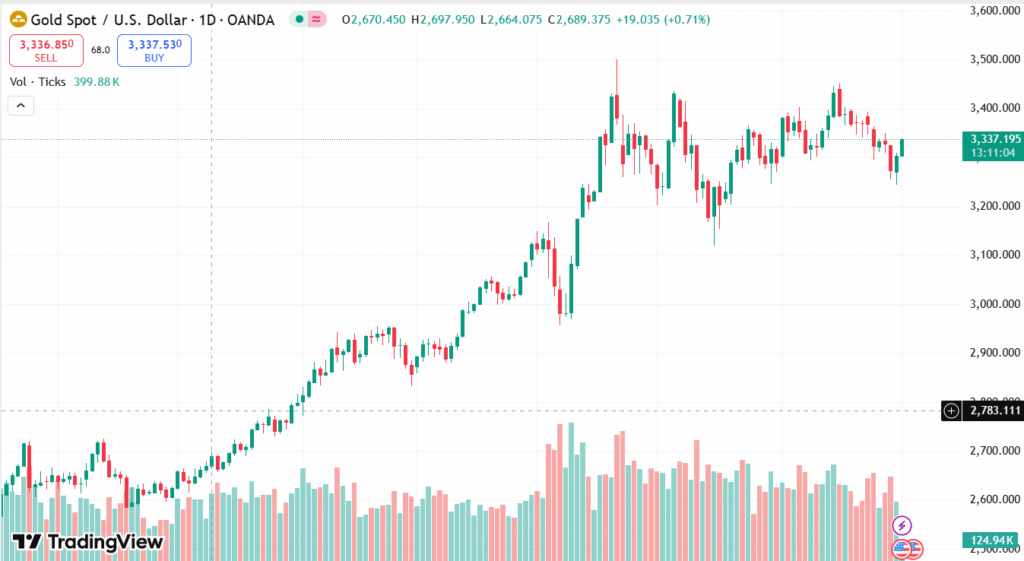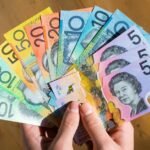Gold prices are moving higher, reaching a three-day high of around $3,333 on increasing hopes of a Federal Reserve rate cut and increased geopolitical trade uncertainties. The US Dollar dipped to its lowest point since February 2022, as the downwardly pressured economic data, fears of a widening fiscal deficit, and Trump’s hawkish trade approach before the July 9 tariff expiration day weighed. Safe-haven interest in gold is also underpinned by political tensions and volatility around key US macroeconomic events during the week, such as the ISM Manufacturing PMI, JOLTS, and highly expected Nonfarm Payrolls report.
KEY LOOKOUTS
• Markets are factoring in a 74% possibility of a Fed rate cut in September, with scope for easing as early as July, which continues to sustain gold prices.
• The USD has fallen to its lowest level since February 2022 on the back of growing fiscal worries and dovish expectations of monetary policy.
• Trump’s latest tariff threat on several nations may ignite safe-haven buying and push gold even higher.
• Major releases such as the ISM Manufacturing PMI, JOLTS, and Thursday’s Nonfarm Payrolls will be keenly observed for new direction in USD and gold price movements.

Gold prices are still rising as investors react to increasing hopes of a Federal Reserve rate cut and rising global trade tensions. The weakening US Dollar, which has fallen to its lowest level since February 2022, reflects market concerns over the Fed’s potential policy easing and the deteriorating fiscal outlook. Adding to the safe-haven appeal of gold are uncertainties surrounding former President Trump’s aggressive tariff policies, with the July 9 deadline looming. Traders also look toward critical US economic reports this week—such as the ISM Manufacturing PMI, JOLTS, and Nonfarm Payrolls report—that may continue to impact gold’s near-term trend.
Gold prices rise with Fed rate cut expectations and trade uncertainty supporting safe-haven demand. A softer US Dollar and threatened tariffs by Trump further bolster the bullish case. Traders now look to critical US data, including the NFP report, for additional guidance.
• Gold prices increase for the second day in a row, hitting approximately $3,333 on the back of firm safe-haven demand.
• Expectations of a potential Fed rate cut before September increase gold and push the US Dollar down.
• The USD declines to its lowest level since February 2022 as a result of fiscal worries and poor economic data.
• Trump’s fresh trade warnings prior to the July 9 deadline contribute to global uncertainty and underpin gold.
• US Treasury Secretary hints at potential tariff increases from 11% to 50%, reinforcing market conservativeness.
• Market participants are looking for important US macroeconomic releases such as ISM Manufacturing PMI, JOLTS, and NFP.
• Technical resistance is around $3,350–$3,370 and major support is at $3,245–$3,200.
Gold remains a focus for investors as world markets respond to a combination of economic and political events. Increasing bets the Federal Reserve will follow quickly with rate cuts in coming weeks have reduced the US Dollar, boosting the allure of gold as a non-yielding haven asset. In the meantime, recent indicators of shrinking consumer spending and worries about a growing federal deficit are putting further pressure on the central bank to step in, supporting the market’s dovish bias.
XAU/USD DAILY PRICE CHART

SOURCE: TradingView
Geopolitical uncertainty is also playing a significant part in favoring gold. Former President Donald Trump has intensified his trade rhetoric, threatening higher tariffs on nations that don’t seal agreements before the July 9 deadline. Those threats and the prospect of rising trade tensions have contributed to investor wariness. As markets expect major US economic releases this week, gold is preferred by traders who want stability in the face of economic and policy-related uncertainties.
TECHNICAL ANALYSIS
Gold (XAU/USD) is depicting a consistent bullish inclination while it is trading close to a three-day high level of $3,333. The nearest resistance can be seen in the $3,324–$3,325 range, a breakout above which might pave the way for additional upsides towards the $3,350 and $3,370 levels. Long-term strength above these levels can push the price towards the psychological $3,400 level. On the downside, initial support comes at $3,300, followed by stronger support around $3,276 and $3,245. A fall below these levels may switch momentum back in the favor of the bears and reveal the $3,210–$3,200 zone.

FORECAST
Gold could pierce near-term resistance at the $3,325 level and target the next significant barrier at $3,350. A clear breach above this level could set the stage for the $3,370 area, and eventually, the psychological $3,400 threshold. Sustained dollar weakness, added assurance on Fed rate cut expectations, and growing worldwide trade tensions would more than likely drive further rises in gold prices.
Conversely, inability to hold above the $3,300 support level may invite a bearish pullback, revealing the $3,276 and $3,245 levels. A break below these supports might speed up the fall towards the $3,210–$3,200 range. Further downside risk might emerge if future US macroeconomic indicators surprise to the upside, alleviating pressure on the Fed and bolstering the US Dollar, hence diminishing the safe-haven appeal of gold.







